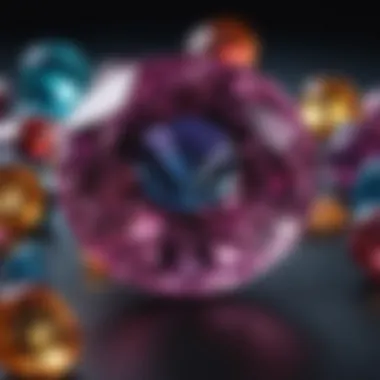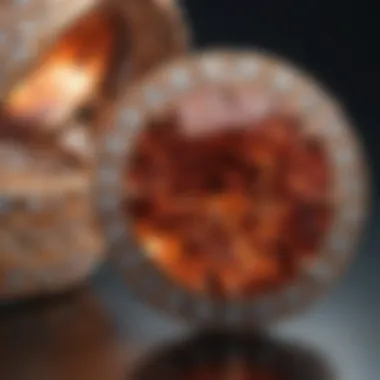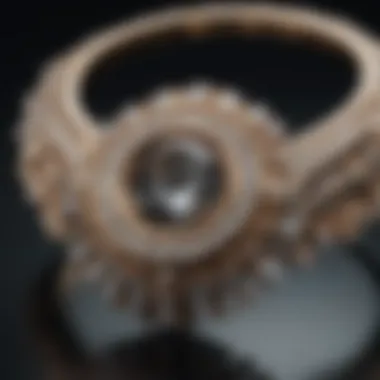Exploring the Finest Jewelry Brands for Quality


Intro
Jewelry has always held a significant place in human culture, representing not only personal adornment but also artistic expression and cultural identity. Quality jewelry brands have an enduring reputation for elegance and craftsmanship that stands the test of time. This article seeks to explore the rich landscape of such brands, identifying the critical factors that contribute to their standing in the industry. Through the lens of design evolution, craftsmanship, and market perceptions, readers will gain insights into distinguishing high-quality jewelry and the factors influencing investment in these exquisite pieces.
As the demand for unique and enduring designs continues to rise, understanding the intricate details that set these brands apart becomes essential. This guide also addresses contemporary trends, helping women of varying ages to navigate their choices with discernment and confidence.
Quality jewelry brands do not just sell products; they offer stories, heritage, and access to tradition, making it vital for any prospective buyer to be informed about what they are investing in.
Prologue to Jewelry Quality
Jewelry serves as a reflection of personal style, often becoming a significant part of a person’s identity. Thus, understanding the concept of quality in jewelry is paramount. This section will highlight what makes quality jewelry not just valuable in terms of cost, but also indispensable in terms of durability, beauty, and craftsmanship.
Defining Quality in Jewelry
Quality in jewelry encompasses various factors like the materials used, design precision, and overall durability. When evaluating jewelry, one must consider the type of metals employed; for instance, pieces made from platinum or high-karat gold are typically deemed higher in quality. Additionally, the intricacy of stone settings and the finish of the piece also contribute to its quality. It is not merely about aesthetics; it is about how long a piece will last and maintain its allure.
The clarity of gemstones—a critical aspect when discussing quality—plays a considerable role too. High-quality gems often possess fewer inclusions and exhibit better color saturation. Thus, when assessing quality, both physical properties and aesthetic appeal intertwine, providing a holistic view of what quality jewelry entails.
The Importance of Craftsmanship
Craftsmanship is the backbone of high-quality jewelry. Skilled artisans bring years of experience and artistry to their work. They not only sculpt metals or set stones but also instill a sense of personal touch that mass-produced jewelry simply cannot replicate.
Moreover, craftsmanship dictates the longevity of jewelry. Well-crafted pieces stand the test of time, both in terms of style and physical wear. For instance, precise setting techniques can prevent the loss of stones, thereby maintaining the integrity of the piece.
Moreover, the meticulous nature of craftsmanship often leads to unique designs and limited editions, making the pieces sought after in the market. Often, these creators employ time-honored techniques passed down through generations, ensuring that each creation is not only a piece of jewelry but a narrative that carries historical significance.
"Craftsmanship is about thoughtful design and execution in every detail. It's what separates lasting quality from transient fashion."
Historical Context of Jewelry Brands
Understanding the historical context of jewelry brands is crucial for recognizing their prestige and value in contemporary markets. Jewelry has been part of human culture for thousands of years, reflecting societal values, technological advancements, and artistic trends. This deep-rooted history informs how brands are perceived today and contributes to their heritage. It is essential to grasp this background when exploring the features that define quality in jewelry.
The Evolution of Jewelry Design
The evolution of jewelry design showcases how styles and materials have changed in response to cultural, technological, and socio-economic factors. In ancient civilizations, jewelry often held symbolic meanings rather than merely decorative purposes. For example, in Egypt, gold was revered not only for its beauty but also for its association with the divine. As society progressed to the Middle Ages, designs became more intricate, influenced by religion and royalty.
In modern times, the Industrial Revolution initiated a shift. Mass production allowed for wider access to jewelry, reducing the exclusivity that characterized earlier periods. During the late 19th and early 20th centuries, movements such as Art Nouveau emerged, emphasizing nature-inspired forms and craftsmanship, which marked a significant change in design philosophy.
Contemporary jewelry design reflects a blend of these historical styles while incorporating modern materials like synthetic stones and sustainable options. Today, brands are focusing on not just aesthetics but also the story behind the piece, with many aiming to create a balance between heritage and innovation.
Key Milestones in Brand Development
The journey of individual jewelry brands often mirrors broader historical trends and milestones in the industry. For instance, in the 1830s, Charles Lewis Tiffany founded Tiffany & Co., bringing a unique vision of elegance and quality to the market. This marked the beginning of a new era where jewelry was not just a reflection of wealth but also of personal style and sentiment.
Cartier, established in 1847, became synonymous with luxury and sophistication. Its creations have been adorned by royalty and celebrities alike, shaping the brand into a historical icon. Key milestones often relate to significant events like the introduction of specific collections or groundbreaking designs. For example, the introduction of the Cartier love bracelet in the 1970s changed personal adornment, becoming a symbol of love and commitment.


Bulgari, founded in 1884, embraced bold colors and geometric shapes, establishing its brand identity distinctively through innovative designs linked to Italian culture. These brands not only represent milestones in the jewelry industry but also reflect the changing tastes and values of their time.
In summary, the historical context of jewelry brands is essential for understanding their identity and craftsmanship today. By acknowledging the evolution of design and key milestones in brand development, one can better appreciate the quality and distinctiveness of prominent jewelry brands.
Prominent Jewelry Brands to Consider
When it comes to high-quality jewelry, certain brands have established themselves as the pinnacle of elegance and sophistication. Understanding the attributes and philosophies behind these brands enhances one’s ability to make informed decisions in jewelry purchases. Each brand offers a distinct aesthetic and craftsmanship that resonates with different personal tastes. Recognizing the significance of these brands provides insight into the trends, innovations, and enduring qualities that define luxury jewelry.
Tiffany & Co.: A Legacy of Elegance
Tiffany & Co. is synonymous with timeless beauty and exquisite craftsmanship. Founded in 1837, the brand has built a reputation centered on elegance and luxury. The iconic Tiffany Blue box is widely recognized, representing not just a product, but a cherished moment. The company's commitment to quality begins with ethically sourced materials, ensuring the authenticity and value of every piece.
Tiffany & Co. is also credited with pioneering advancements in jewelry design. The Tiffany Setting for engagement rings revolutionized the way diamonds are presented, allowing maximum light to shine through. This innovation reflects the brand’s dedication to craftsmanship and innovation. It remains a significant part of its identity.
Cartier: Timeless Luxury
Cartier is another esteemed brand in the jewelry world, known for its intricate designs and luxurious appeal. Established in 1847, Cartier has adorned royals and celebrities alike. The brand’s philosophy revolves around creating art through fine jewelry. Its designs often incorporate cultural motifs and historical references. Notable pieces like the Love bracelet and Tank watch showcase the enduring nature of its artistry.
The brand emphasizes high-quality materials, including gold and precious stones. Its commitment to craftsmanship ensures that every piece is meticulously made. For many, Cartier jewelry represents an investment in heritage and style, combining sophistication with timeless allure.
Bulgari: Bold Italian Statement
Bulgari stands out for its bold aesthetic and vibrant combinations of color. Originating in Greece and flourishing in Italy, the brand showcases an eclectic style that reflects its cultural heritage. Founded in 1884, Bulgari has built a unique identity through innovative designs and a daring approach to gemstones.
The use of vivid colors, particularly in its Serpenti collection and B.zero1 rings, emphasizes a playful yet luxurious sensibility. Bulgari emphasizes craftsmanship through hand-worked techniques and attention to detail. This ensures that each piece is not only stunning but also a representation of true Italian artistry.
Van Cleef & Arpels: Artistry in Motion
Van Cleef & Arpels embodies the art of jewelry making with its whimsical designs and strong focus on nature. Established in 1906, the brand is celebrated for its intricate mechanisms, such as the Alhambra collection which symbolizes good luck. Each piece reflects a story, often inspired by flora and fauna, showcasing not just artistry but narrative expression.
The brand’s unique craftsmanship shines through its mystery setting technique, which allows stones to be set without visible mountings. This subtle design choice elevates the beauty of each gemstone, making Van Cleef & Arpels a favorite among those who value artistry in jewelry.
Chopard: Refined Craftsmanship
Chopard is synonymous with refined craftsmanship and ethical luxury. Founded in 1860, the brand is notable for its commitment to sustainable practices, ensuring that each piece is produced with integrity. Chopard’s Happy Diamonds collection is particularly famous for its playful yet elegant design, featuring free-moving diamonds that dance within the setting.
Chopard also prioritizes high-quality materials, with an emphasis on responsible sourcing. Its dedication to fine craftsmanship is evident in every jewelry piece. For shoppers considering an investment in jewelry, Chopard represents a blend of luxury and social responsibility, appealing to a discerning clientele.
"Choosing a jewelry brand is a reflection of personal values and style. It is important to consider not only aesthetics but also the heritage and craftsmanship behind the pieces."
Understanding these prominent jewelry brands can guide potential buyers in selecting pieces that not only enhance their personal style but also serve as lasting investments. When investing in jewelry, considering the brand's history and reputation for quality is essential for ensuring satisfaction with one’s choices.
Evaluating Quality in Jewelry
When considering an investment in jewelry, evaluating quality is crucial. The value and longevity of jewelry go beyond its aesthetic appeal. Understanding the fundamental attributes of jewelry, including the materials used, craftsmanship, and certification, contributes significantly to making informed purchasing decisions. Such evaluations can help ensure that a piece not only meets personal taste but also serves as a sustainable investment. In this section, we will look closely at the significance of materials and gemstone certification to understand their influence on jewelry quality.
Materials and Their Significance


Precious Metals
Precious metals, like gold, silver, and platinum, play a vital role in jewelry quality. Their intrinsic value and resistance to tarnishing make them a popular choice among artisans and consumers alike. High gold content, expressed in karats, is often perceived as a benchmark for quality. For instance, 18-karat gold consists of 75% pure gold, whereas 14-karat gold has 58.3%.
Not only do precious metals provide durability, but they also influence the overall aesthetic of jewelry. Their ability to take on various finishes, such as polished, matte, or brushed, allows for versatility in design. However, the soft nature of certain metals like gold can make them susceptible to scratches. This is an important consideration for wearers who desire pieces that stand up to daily use.
- Key Characteristics: Intrinsically valuable, excellent longevity, various finishes are possible.
- Advantages: Lasting appeal, re-sell value, timeless nature.
- Disadvantages: Can be softer than alternative materials, requiring careful handling.
Gemstone Quality Grading
The grading of gemstones is crucial for determining their quality. This grading system takes into account four main factors, often referred to as the "Four Cs": Cut, Color, Clarity, and Carat weight. A well-cut gemstone will reflect light beautifully, enhancing its visual appeal. The color quality is essential as it affects desirability and value, with more vibrant colors typically fetching higher prices. Clarity addresses the presence of inclusions and blemishes, impacting the stone's overall perfection. Finally, the carat weight indicates size, which can heavily influence pricing.
Understanding how these grading elements work helps consumers assess the worth of their investment. Properly graded gemstones ensure not only aesthetic beauty but also help buyers gauge the longevity and resale value of their jewelry.
- Key Characteristics: Affects visual appeal and market price.
- Advantages: Provides a framework for assessing quality, enhances understanding of value.
- Disadvantages: Requires knowledge for accurate assessments, can be complex for first-time buyers.
Understanding Gemstone Certification
Gemstone certification is essential in the jewelry market. Independent gemological laboratories offer grading reports that validate the quality of the stones. Certification includes details about the stone's origin, treatment history, and quality grading according to recognized standards. This documentation serves as a guarantee of authenticity and can significantly impact resale value.
Furthermore, certified gemstones can provide buyers with peace of mind. Knowing that a stone has been evaluated by a reputable authority can instill confidence in its quality and prevent potential fraudulent purchases. Buyers can make educated choices based on certified information, allowing for informed investments.
"A certified gemstone not only holds intrinsic value but also provides assurance of quality that can stand the test of time."
Trends in Jewelry Design
Jewelry design is continually evolving, reflecting changes in society, culture, and personal expression. Understanding current trends can guide buyers towards selecting pieces that not only resonate with contemporary aesthetics but also hold lasting appeal. This section discusses significant trends that offer valuable insights into how modern jewelry is conceived and appreciated.
Sustainable and Ethical Practices
In recent years, there has been a notable shift towards sustainability and ethical practices in the jewelry industry. Consumers are becoming more aware of the environmental and social impact of their purchases. Brands are now adopting sustainable sourcing methods, utilizing recycled materials, and ensuring fair labor practices. This trend is significant because it not only addresses consumer demand for responsible choices, but it also fosters a more transparent industry.
Jewelry made from eco-friendly materials such as ethically sourced diamonds or lab-grown gemstones is gaining popularity. Many brands are voluntarily adhering to standards set by organizations like the Responsible Jewelry Council, promoting accountability in the supply chain. These practices appeal especially to younger generations who prioritize values over traditional luxury. Additionally, many prefer brands that showcase their commitment to sustainability through certifications or partnerships with environmental organizations.
Considerations for consumers include:
- Look for certifications that guarantee ethical practices.
- Research brands to understand their sourcing policies.
- Assess the longevity of materials used in the jewelry to promote sustainability.
Customization and Personalization
Customization and personalization in jewelry design have become increasingly prominent. This trend empowers consumers to create unique pieces that represent their individuality. Custom jewelry can range from personalized engravings to bespoke designs that capture personal stories or milestones.
Brand engagement with customers is enhanced through these offerings. Many jewelers now provide the option for customers to select materials, designs, and sizes suited to their preferences. This approach allows for deeper connections between the customer and the brand, as each piece tells a personal story.
Benefits of customization include:


- Emotional value: Custom pieces often hold significant personal meaning.
- Unique expression: Consumers can express their identity visibly through tailored designs.
- Gift-giving advantages: Personalized jewelry makes thoughtful gifts for special occasions.
The rise of technology, such as online design tools, has facilitated this trend, enabling consumers to visualize their creations. As consumers increasingly seek meaningful connections to the items they wear, this trend is likely to endure.
The shift towards sustainable practices and customization reflects a broader shift in consumer values, emphasizing individuality and responsibility in purchasing.
Investment Perspective on Quality Jewelry
Understanding the investment potential of quality jewelry is crucial for anyone looking to make a purchase. Jewelry is often perceived as mere adornment, yet it embodies significant value that can appreciate over time. This section offers insights into valuing quality pieces not only for their aesthetic appeal but also as investment opportunities.
Understanding Value Retention
Value retention in jewelry is determined by various factors such as brand reputation, rarity, and market demand. High-quality brands, like Tiffany & Co. and Cartier, often maintain their value well due to their established legacies. Collectors and investors tend to favor pieces from these brands because they not only signify luxury but also denote reliable investment.
Several key elements contribute to value retention, including:
- Brand Heritage: The history and prestige of the brand can greatly influence value. Established brands often have loyal customer bases that enhance demand over time.
- Material Quality: High-quality materials, such as 18k gold, platinum, and certifiably graded diamonds, contribute significantly to the overall value of jewelry. These materials are more likely to withstand market fluctuations.
- Limited Editions and Unique Designs: Pieces that are part of limited collections or feature unique craftsmanship can see increased value. Rarity often drives demand.
The appreciation of jewelry value is not immediate, but over time it becomes evident, making it a long-term investment strategy.
Resale Potential of High-Quality Pieces
The resale potential of high-quality jewelry is another important consideration for investors. Not all jewelry appreciates or retains value equally; thus, understanding the market is vital. Certain brands and styles tend to perform better on the resale market for the following reasons:
- Market Trends: Following trends can help investors predict which styles or brands will be in demand. Keeping an eye on fashion influences and cultural shifts can be beneficial.
- Certification: Pieces that come with proper certification, like those from the Gemological Institute of America (GIA), are more desirable in the resale market. Buyers feel more secure investing in certified items.
- Condition and Maintenance: The condition of the piece plays a significant role in its resale value. Regular maintenance and proper storage can keep jewelry in pristine condition, enhancing its resale potential.
High-quality jewelry can be more than just an accessory; it is an investment that can yield returns over time.
Ultimately, understanding the dynamics of value retention and resale potential is essential for making informed choices in the jewelry market. Investing in quality pieces can lead to both personal joy and potential financial benefits.
Culmination: Making Informed Choices
Making informed choices when it comes to purchasing high-quality jewelry is essential for any buyer. This article has laid out various aspects of jewelry quality, craftsmanship, and brand reputation. As readers contemplate their jewelry investments, they must consider several factors that can influence their choices.
First, recognizing your personal style helps in selecting pieces that are not only aesthetically pleasing but also resonate with your identity. Understanding how certain styles complement your wardrobe is vital. Further, the craftsmanship behind the pieces you choose also plays a big role. High-quality jewelry is an investment, and the durability and timelessness align closely with how these items fit into your overall lifestyle.
Additionally, the importance of ethical considerations cannot be overstated. As the market pivots towards sustainable and conflict-free options, buyers should evaluate the practices of brands and make choices in line with their values. Transparency in sourcing materials, along with ethical labor practices, must be among the criteria when selecting a jeweler.
Each piece of jewelry represents a unique story and contributes to your collection. Investing your time in careful research can reveal hidden gems in a cluttered market. Overall, making informed choices is not just about spending money; it’s about ensuring that your selections bring joy and maintain their value over time.
"When you invest in quality jewelry, you are not merely purchasing an item; you are acquiring a piece of art that can be cherished for generations."
Evaluating Your Personal Style
Understanding your personal style is the first step in making a wise jewelry purchase. Every individual has a unique aesthetic, often influenced by their lifestyle, clothing, and personal preferences. Determine which pieces resonate with your fashion sense—are you drawn to classic designs, or do modern styles appeal to you more? Carving out the time to think about this will impact not only your satisfaction but also how often you wear the jewelry you buy.
You can start by assessing what you already own. Look at your current jewelry collection and identify common themes. Are there certain materials, colors, or types of jewelry that you frequently wear over others? Engaging in this self-assessment will help you better understand which new purchases will blend seamlessly into your existing collection.
Where to Start Your Search
Once you have identified your personal style, the next step is knowing where to search for quality jewelry. Begin by exploring reputable jewelers and brands noted for their craftsmanship. For instance, brands like Tiffany & Co. and Cartier have longstanding reputations for quality and design. Online platforms also provide a wealth of options, but ensure the sellers are credible and transparent about their practices.
Visiting official websites or local boutiques allows you to appreciate the quality firsthand. Attending jewelry exhibitions or shows can also expose you to a variety of designers and styles. Additionally, reading customer reviews on platforms like Reddit or Facebook can provide insights on brand reliability and quality.



